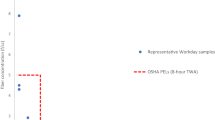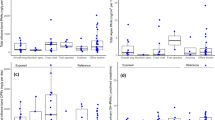Abstract
Exposure assessments are key tools to conduct epidemiological studies. Since 2010, 28 riveters from 18 brake repair shops with different characteristics and workloads were sampled for asbestos exposure in Bogotá, Colombia. Short-term personal samples collected during manipulation activities of brake products, and personal samples collected during non-manipulation activities were used to calculate 103 8-h TWA PCM-equivalent personal asbestos concentrations. The aims of this study are to identify exposure determinant variables associated with the 8-h TWA personal asbestos concentrations among brake mechanics, and propose different models to estimate potential asbestos exposure of brake mechanics in an 8-h work-shift. Longitudinal-based multivariate linear regression models were used to determine the association between personal asbestos concentrations in a work-shift with different variables related to work tasks and workload of the mechanics, and some characteristics of the shops. Monte Carlo simulations were used to estimate the 8-h TWA PCM-Eq personal asbestos concentration in work-shifts that had manipulations of brake products or cleaning activities of the manipulation area, using the results of the sampling campaigns. The simulations proposed could be applied for both current and retrospective studies to determine personal asbestos exposures of brake mechanics, without the need of sampling campaigns or historical data of air asbestos concentrations.
This is a preview of subscription content, access via your institution
Access options
Subscribe to this journal
Receive 6 print issues and online access
$259.00 per year
only $43.17 per issue
Buy this article
- Purchase on Springer Link
- Instant access to full article PDF
Prices may be subject to local taxes which are calculated during checkout

Similar content being viewed by others
References
CDC. Current Intelligence Bulletin 62. Asbestos Fibers and Other Elongate Mineral Particles: State of the Science and Roadmap for Research. Revised Edition. Department of Health and Human Services, Centers for Disease Control and Prevention, National Institute for Occupational Safety and Health: Cincinnati, Ohio, USA, 2011.
ATSDR Toxicology Profile For Asbestos. Agency for Toxic Substances and Disease Registry. US Department of Health and Human Services: Atlanta, GA. 2001.
OMS. Fact Sheet N 343. Asbestos Elimination of Asbestos Related Diseases, 2010. Available at http://www.who.int/mediacentre/factsheets/fs343/en/index.html. Accessed on February 2013.
IARC. Asbestos (Actinolite, Amosite, Anthophyllite, Chrysotile, Crocidolite, Tremolite) Supplement 7, 1987. Available at http://www.inchem.org/documents/iarc/suppl7/asbestos.html. Accessed on 22 February 2010.
IARC. IARC Monographs on the Evaluation of Carcinogenic Risks to Humans. Asbestos (chrysotile, amosite, crocidolite, tremolite, actinolite, and anthophyllite). Volume 100C, 2012. Available at http://monographs.iarc.fr/ENG/Monographs/vol100C/index.php. Accessed on October 2015.
Wagner GR, Lemen R . Asbestos. In: Heggenhougen K editor. International Encyclopedia of Public Health. Academic Press. 2008.
ACSH. Asbestos Exposure: How Risky Is It? New York 2007. Available at http://www.acsh.org/docLib/20071015_Asbestos.pdf. Accessed on January 2011.
OIT. Convenio 162 de la OIT, sobre la utilización del asbesto en condiciones de seguridad. Instituto Nacional de Seguridad e Higiene en el Trabajo. Organización Internacional del Trabajo. España 1986. Available at http://www.insht.es/InshtWeb/Contenidos/Normativa/TextosLegales/Convenios/C162/PDFs/convenio162delaoitsobreutilizaciondelasbestoencondiciones.pdf. Accessed on January 2011.
Nieuwenhuijsen M, Paustenbach DJ, Duarte-Davidson R . New developments in exposure assessment: the impact on the practice of health risk assessment and epidemiological studies. Environ Int 2006; 32: 996–1009.
NIOSH. 7400 Asbestos and other fibers by PCM, 1994. Available at http://www.cdc.gov/niosh/docs/2003-154/pdfs/7400.pdf. Accessed on February 2010.
NIOSH. 7402 Asbestos by TEM, 1994. Available at http://www.cdc.gov/niosh/docs/2003-154/pdfs/7402.pdf. Accessed on February 2010.
Breysse PN . Electron microscopic analysis of airborne asbestos fibers. Crit Rev Anal Chem 1991; 22: 201–227.
ACGIH. TLVs and BEIs. Based on the Documentation of the Threshold Limit Values for Chemical Substances and Physical Agents & Biological Exposure Indices, Cincinnati, OH, USA 2015. Available at https://www.acgih.org/forms/store/ProductFormPublic/documentation-of-the-threshold-limit-values-and-biological-exposure-indices-7th-edition-2015-supplement. Accessed on December 2015.
OSHA. Occupational Safety and Health Standards. Toxic and Hazardous Substances - Asbestos. (Standards - 29CFR) 1910-1001, Washington, DC, 1994. Available at https://www.osha.gov/pls/oshaweb/owadisp.show_document?p_table=STANDARDS&p_id=9995. Accessed on November 2013.
MSPS. Ministerio de Salud y Protección Social. 2011. Resolución 007 de 2011, por la cual se adopta el Reglamento de Higiene y Seguridad del Crisotilo y otras fibras de uso similar, 2011Available at http://fondoriesgoslaborales.gov.co/documents/Normatividad/Resoluciones/res-007-2011.pdf. Accessed on November 2011.
Hodgson JT, Darnton A . The quantitative risks of mesothelioma and lung cancer in relation to asbestos exposure. Ann Occup Hyg 2000; 44: 565–601.
De Vocht F, Northage C, Money C, Cherrie JW, Rajan-Sithamparanadarajah B, Egeghy P et al. The future of exposure assessment: perspectives from the X2012 Conference. Ann Occup Hyg 2013; 57: 280–285.
Burdorf A, Heederik D . Applying quality criteria to exposure in asbestos epidemiology increases the estimated risk. Ann Occup Hyg 2011; 55: 565–568.
Peters S, Vermeulen R, Olsson A, Van Gelder R, Kendzia B, Vincent R et al. Development of an exposure measurement database on five lung carcinogens (ExpoSYN) for quantitative retrospective occupational exposure assessment. Ann Occup Hyg 2012; 56: 70–79.
Tinnerberg H, Heikkilä P, Huici-Montagud A, Bernal F, Forni A, Wanders S et al. Retrospective exposure assessment and quality control in an international multi-centre case–control study. Ann Occup Hyg 2003; 47: 37–47.
Anttila P, Heikkilä P, Mäkelä M, Schlünssen V, Priha E . retrospective exposure assessment for carcinogenic agents in Bitumen waterproofing industry in Finland and Denmark. Ann Occup Hyg 2009; 53: 139–151.
Herdt-Losavio ML, Mauer MP, Carlson GA . Development of an exposure assessment method for epidemiological studies of New York State personnel who responded to the World Trade Center disaster. Ann Occup Hyg 2008; 52: 83–93.
Tielemans E, Schneider T, Goede H, Tischer M, Warren N, Kromhout H et al. Conceptual model for assessment of inhalation exposure: defining modifying factors. Ann Occup Hyg 2008; 52: 577–586.
Tielemans E, Noy D, Schinkel J, Heussen H, Van Der Schaaf D, West J et al. Stoffenmanager exposure model: development of a quantitative algorithm. Ann Occup Hyg 2008; 52: 443–454.
Burdorf A, Swuste P . An expert system for the evaluation of historical asbestos exposure as diagnostic criterion in asbestos-related diseases. Ann Occup Hyg 1999; 43: 57–66.
Finley BL, Richter RO, Mowat FS, Mlynarek S, Paustenbach DJ, Warmerdam JM et al. Cumulative asbestos exposure for US automobile mechanics involved in brake repair (circa 1950s - 2000). J Expo Sci Environ Epidemiol 2007; 17: 644–655.
Kazan-Allen L . Asbestos and mesothelioma: worldwide trends. Lung Cancer 2005; 49 (Supp 1): S3–S8.
Sly PD, Chase R, Kolbe J, Thompson P, Gupta L, Daube M et al. Asbestos still poses a threat to global health: now is the time for action. Med J Aust 2010; 193: 198–199.
LaDou J, Castleman B, Frank A, Gochfeld M, Greenberg M, Huff J et al. The case for a global ban on asbestos. Environ Health Perspect 2010; 118: 5.
Tossavainen A . El asbesto en el mundo: Producción, Uso e Incidencia de las enfermedades relacionadas con asbesto. Ciencia Trabajo 2008; 27: 7–13.
Mittelstae M . Exports controversy brews over asbestos deaths in Mexico Saturday´s Globe 2010.
Cely-García MF, Sánchez M, Breysse PN, Ramos-Bonilla JP . Personal exposures to asbestos fibers during brake maintenance of passenger vehicles. Ann Occup Hyg 2012; 56: 985–999.
Cely-Garcia MF, Torres-Duque CA, Duran M, Parada P, Sarmiento OL, Breysse PN et al. Personal exposure to asbestos and respiratory health of heavy vehicle brake mechanics. J Expos Sci Environ Epidemiol 2014; 1: 26–36.
Cely-García MF, Curriero FC, Giraldo MM, Méndez L, Breysse PN, Durán M et al. Factors associated with non-compliance of asbestos occupational standards in brake repair workers. Ann Occup Hyg 2016; 60: 1020–1035.
Salazar N, Cely-García MF, Breysse PN, Ramos-Bonilla JP . Asbestos exposure among transmission mechanics in automotive repair shops. Ann Occup Hyg 2014; 59: 292–306.
Forensic Analytical Laboratories I. Analytical Methods, 2016 (Personal Communication).
EPA. Exposure Factors Handbook 2011 Edition, National Center for Environmental Assessment, Washington, DC. EPA/600/R-09/052F, 2011 Nationa Technical Information Service: Springfield, VA, Available at http://www.epa.gov/ncea/efh. Accessed on August 2013.
OSHA. Personal Sampling For Air Contaminants. OSHA Technical Manual (OTM). Section II: Chapter 1, 2008. Available at https://www.osha.gov/dts/osta/otm/otm_ii/otm_ii_1.html#order_sampling_media. Accessed on July 2013.
EPA. Method for the Determination of Asbestos in Bulk Building Materials. EPA/600/R-93/116, 1993. Available at http://www.epa.gov/region1/info/testmethods/pdfs/EPA_600R93116bulk_asbestos_part1.pdf. Accessed on June 2014.
Stata. vce_options - Variance estimators, 2015. Available at http://www.stata.com/manuals13/xtvce_options.pdf. Accessed on January 2015.
UCLA. Regression with Stata. Chapter 4 – Beyond OLS. UCLA Statistical Consulting Group, 2015. Available at http://www.ats.ucla.edu/stat/stata/webbooks/reg/chapter4/statareg4.htm. Accessed on January 2015.
UCLA. Analyzing Correlated (Clustered) Data. UCLA Statistical Consulting Group, 2015. Available at http://www.ats.ucla.edu/stat/stata/library/cpsu.htm. Accessed on January 2015.
Cherrie JW, Maccalman L, Fransman W, Tielmans E, Tischer M, Van Tongeren M . Revisiting the effect of room size and general ventilation on the relationship between near- and far-field air concentrations. Ann Occup Hyg 2011; 55: 1006–1015.
Cherrie JW, Schneider T . Validation of a new method for structured subjective assessment of past concentrations. Ann Occup Hyg 1999; 43: 235–245.
UCLA. How Do I Interpret a Regression Model When Some Variables Are Log Transformed? UCLA Statistical Consulting Group, 2015. Available at http://www.ats.ucla.edu/stat/mult_pkg/faq/general/log_transformed_regression.htm.
Benoit K . Linear Regression Models with Logarithmic Transformations, 2011 (London School of Economics and Political Science manuscript). Available at http://www.kenbenoit.net/courses/ME104/logmodels2.pdf. Accessed on 27 August 2013.
Bacchetti P . Logarithmic Transformations, 2013. Available at https://www.ctspedia.org/do/view/CTSpedia/LogTransformation. Accessed on 22 August 2013.
UCLA. Regression with Stata. Chapter 2 - Regression Diagnostics. UCLA Statistical Consulting Group, 2015. Available at http://www.ats.ucla.edu/stat/stata/webbooks/reg/chapter2/statareg2.htm. Accessed on December 2014.
Sánchez-Silva M. Capítulo 6. Confiabilidad de Componentes. Introducción a la confiabilidad y evaluación de riesgos. Teoría y aplicaciones en ingeniería. 2005. Ediciones Uniandes. Universidad de Los Andes, Bogotá, Colombia..
EPM. EPM Information Development Team. Oracle Crystal Ball, Fusion Edition User's Guide, 2010. Available at http://www.hearne.software/getattachment/ef9f1967-3137-4e71-a744-75bc22a1f490/Support-Documentation-Crystal-Ball-11-1-2-User-Gui.aspx. Accessed on August 2015.
OIT. Seguridad en la Utilización del Amianto. Organización Internacional del Trabajo. Ginebra, 1984. Available at http://aragon.ugt.org/slaboral/normativa/europea/amianto.pdf. Accessed on January 2012.
EPA. 40 CFR Part 763, Subpart I — Prohibition of the Manufacture, Importation, Processing and Distribution in Commerce of Certain Asbestos-Contianing products; Labeling Requirements, 2011. Available at http://www.gpo.gov/fdsys/pkg/CFR-2011-title40-vol31/pdf/CFR-2011-title40-vol31-part763-subpartI.pdf. Accessed on October 2015.
Acknowledgements
This research was funded with the financial support of the Departamento Administrativo de Ciencia, Tecnología e Innovación (Colciencias) grant 567-2012 for Doctoral Students, and Colciencias’ Contract 760-2013 project code 120456933509. Previous studies received funding from Fundación Mapfre (Spain), and the Department of Civil and Environmental Engineering and the School of Engineering at Universidad de Los Andes (Colombia). We thank the owners and workers from the BRS sampled. We also thank graduate students Juliana Uribe and Natalia Salazar for their assistance during sampling campaigns, and María Grau Pérez and Manuela Valenzuela for their advice in the implementation of the statistical models and the simulations performed with Crystal Ball. Information regarding BRS located in different zones of Bogotá gathered by undergraduate Environmental Engineering students from Universidad de Los Andes was greatly appreciated. We also thank Alonso Rojas for his help during sampling campaigns.
Author information
Authors and Affiliations
Corresponding author
Ethics declarations
Competing interests
The authors declare no conflict of interest.
Additional information
Disclaimer
The opinions expressed by Patrick N. Breysse in this article are the author’s own and do not reflect the views of the Centers for Disease Control, the Department of Health and Human Services and the US government.
Supplementary Information accompanies the paper on the Journal of Exposure Science and Environmental Epidemiology website
Rights and permissions
About this article
Cite this article
Cely-García, M., Curriero, F., Sánchez-Silva, M. et al. Estimation of personal exposure to asbestos of brake repair workers. J Expo Sci Environ Epidemiol 27, 417–426 (2017). https://doi.org/10.1038/jes.2016.76
Received:
Revised:
Accepted:
Published:
Issue Date:
DOI: https://doi.org/10.1038/jes.2016.76



